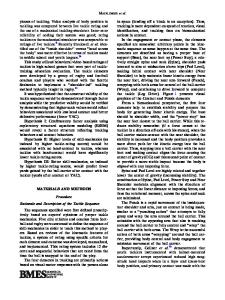On-Field Performance of an Instrumented Mouthguard for Detecting Head Impacts in American Football
- PDF / 1,183,160 Bytes
- 14 Pages / 593.972 x 792 pts Page_size
- 45 Downloads / 317 Views
Annals of Biomedical Engineering (Ó 2020) https://doi.org/10.1007/s10439-020-02654-2
Concussion Biomechanics in Football
On-Field Performance of an Instrumented Mouthguard for Detecting Head Impacts in American Football LEE F. GABLER ,1 SAMUEL H. HUDDLESTON,1 NATHAN Z. DAU,1 DAVID J. LESSLEY,1 KRISTY B. ARBOGAST,2 XAVIER THOMPSON,3 JACOB E. RESCH,3 and JEFF R. CRANDALL1 1 Biomechanics Consulting and Research, LLC, 1627 Quail Run Drive, Charlottesville, VA 22911, USA; 2Center for Injury Research and Prevention, Children’s Hospital of Philadelphia, Philadelphia, PA 19146, USA; and 3Department of Kinesiology, University of Virginia, Charlottesville, VA 22904, USA
(Received 26 August 2020; accepted 8 October 2020) Associate Editor Stefan M Duma oversaw the review of this article.
Abstract—Wearable sensors that accurately record head impacts experienced by athletes during play can enable a wide range of potential applications including equipment improvements, player education, and rule changes. One challenge for wearable systems is their ability to discriminate head impacts from recorded spurious signals. This study describes the development and evaluation of a head impact detection system consisting of a mouthguard sensor and machine learning model for distinguishing head impacts from spurious events in football games. Twenty-one collegiate football athletes participating in 11 games during the 2018 and 2019 seasons wore a custom-fit mouthguard instrumented with linear and angular accelerometers to collect kinematic data. Video was reviewed to classify sensor events, collected from instrumented players that sustained head impacts, as head impacts or spurious events. Data from 2018 games were used to train the ML model to classify head impacts using kinematic data features (127 head impacts; 305 non-head impacts). Performance of the mouthguard sensor and ML model were evaluated using an independent test dataset of 3 games from 2019 (58 head impacts; 74 non-head impacts). Based on the test dataset results, the mouthguard sensor alone detected 81.6% of video-confirmed head impacts while the ML classifier provided 98.3% precision and 100% recall, resulting in an overall head impact detection system that achieved 98.3% precision and 81.6% recall. Keywords—American football, Concussion, Feature engineering, Head kinematics, Instrumented mouthguard, Machine learning, On-field impacts.
Address correspondence to Lee F. Gabler, Biomechanics Consulting and Research, LLC, 1627 Quail Run Drive, Charlottesville, VA 22911, USA. Electronic mail: [email protected]
INTRODUCTION Wearable sensors can provide quantitative athlete head kinematics for evaluating the effectiveness of interventions used in organized sport.30 For example, data from wearable head impact sensors obtained onfield can be used to ensure test methodologies are representative of actual loading conditions, to evaluate changes to rules of the game, and to identify drills and game scenarios that may be associated with a greater number of impacts or impacts of higher
Data Loading...











